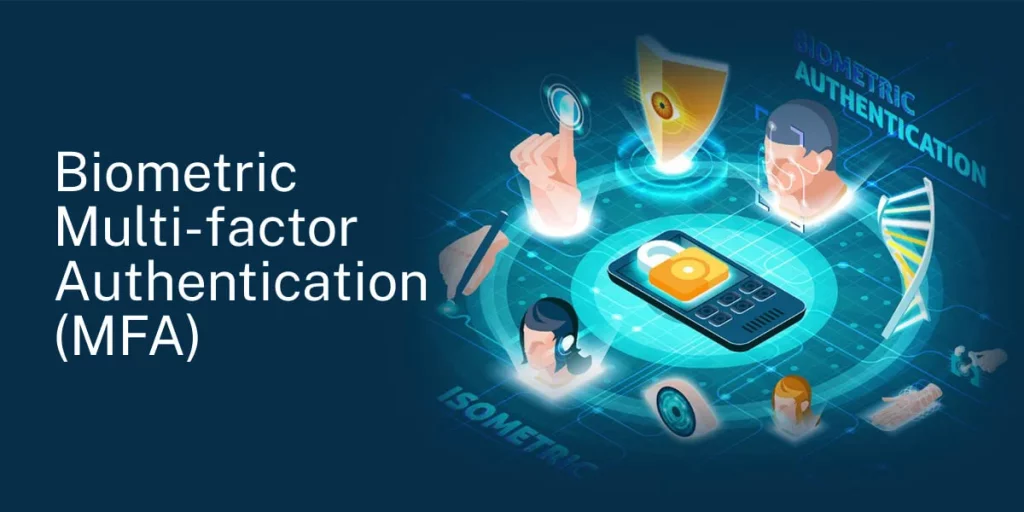
Benefits of Multifactor Biometric Authentication: The digital payment journey is paved with a password, and OTP sent on your mobile or email. The process is even happening in your nearest offline shopping store.
Such drawbacks often result in cart abandonment. Whenever a person validates a transaction, login, or access using two or more methods, it is called Multi-Factor Authentication (MFA).
The concept of Multi-factor Authentication was introduced to boost the security and safety of online users. The second verification factor is a biometric, secret answer, mobile message, etc.
However, biometrics has become a more prominent mode of MFA, as it remains unique to a person, minimizes the scale of identity & data theft, and offers higher convenience.
Their demand is projected to rise beyond $8.8 billion, with nearly $2.2 billion expenditure by end users linked with the financial institutions and banking industry. The rising usage is due to the many advantages of biometric MFA methods, even overpowering traditional MFA methods.
Table of Contents
3 Significant Benefits of Using Biometric Multifactor Authentication

1. Enhances User Experience
The traditional modes of multifactor authentication (MFA) demand entering a One-Time Password (OTP) to ensure access to a genuine user. However, such a process spoils the end user’s onboarding, login, and access process, making it more time-consuming.
As a result, security comes at a price of inconvenience On the other hand, biometric multifactor authentication with passive liveness ensures genuine user login and access within seconds. Moreover, face, voice, palm, fingerprint, and eye recognition methods ensure multimodal and contactless accessibility, even remotely.
So, a biometric authentication system eliminates the dependency on specialized hardware.
Also Read: Prevent Identity Theft Through Biometric Authentication
2. Revamps Security to the Next Level
Primarily, biometrics are unique because they differ from one person to another. As a result, replicating them would require highly sophisticated methods and isn’t any ordinary hacker’s cup of tea.
Nowadays, financial institutions and banks have switched KYC verification through QR scans, video upload with gestures, and other methods, making digital theft even more challenging for cyber criminals.
Also Read: Remote Biometric Digital KYC: The Growing Practices
Biocube has revamped biometric security to an even higher level. Its liveness detection feature eliminates the need for gesture-based video uploads and uses an AI-driven algorithm to distinguish between real humans and fakes.
Cybersecurity venture predicted a ransomware attack on companies globally every 11 seconds. The projected report was based on many factors.
However, biometric security can drastically reduce the alarming exploitation threats from multiple business stakeholders.
Also Read: How Biometrics Enhance Cyber Security?
3. Minimizes Password Fatigue
Biometric authentication has removed the usage of password-based login and access. According to a source, an average employee keeps track of 191 passwords. As a result, the usage of similar passwords for multiple accounts drastically increases.
It is havoc for the IT department, as such a practice makes access vulnerable to hackers. Another study suggests that 91% of employees understand the drawbacks of using a single password for multiple accounts, but 61% still go ahead with the practice.
Identity and access management solutions to resolve this issue to a limit, but they still require manually entering passwords of accounts linked to them. On the other hand, Google allows us to save passwords, which is even a poor choice.
If the account gets hacked, the cybercriminal can get access to a single source of password storage without the consent of the actual account holder.
At times, revoking such access can become late if the account holder doesn’t promptly click on the notification sent to the smartphone or doesn’t have a phone linked to the account.
Moreover, biometric-oriented passwordless login and access with passive liveness eliminate the need to remember strong passwords for multiple accounts or save them using an identity and access management solution.
Hence, it diminishes the potential threat to a user’s digital accounts.
Conclusion
Using biometric multifactor authentication can alter the course of digital security and user convenience by revamping the onboarding, login, and access process. The scalable solutions of the modern-day also eliminate the need for specialized hardware for accessibility.
Biocube is a leader in face, voice, fingerprint, palm, and eye authentication solutions. It adopts passive liveness, industry-reputed encryption, and hardware-agnostic technology to enable multifactor and multimodal accessibility through biometrics.
Get in touch with our leading experts by scheduling a meeting with us and receive a free demo of the advanced technologies used by Biocube to address the problems of the modern-day digital identity user.
Source: This article was originally published by Linkedin. Read the original article here…
